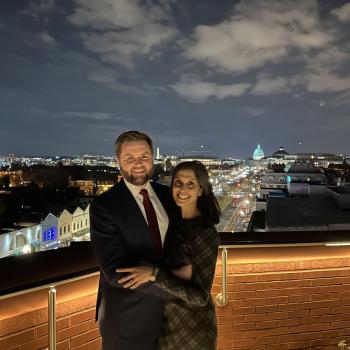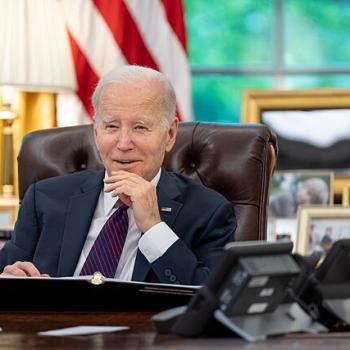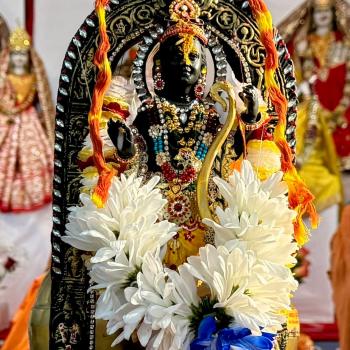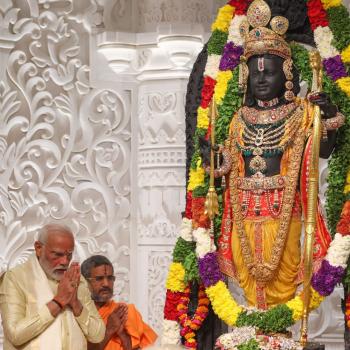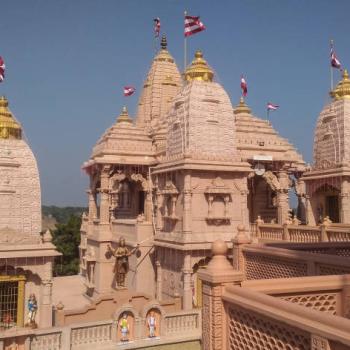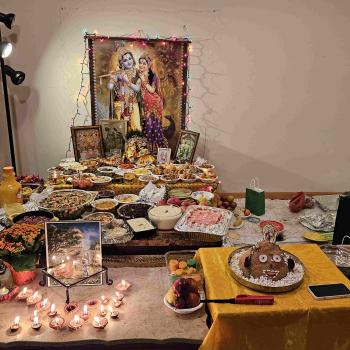In the Bhagwad Gita, one of the most sacred Hindu scriptures, Lord Krishna states that “forgiveness” is one of the great qualities everyone should practice and aspire for. He, however, cautioned not to use forgiveness indiscriminately. This article is about an act of forgiveness, a higher purpose of Divine faith and Hinduism, by the community in Minnesota. The incidence goes as far back as 2006, a part of the history of the Hindu Temple of Minnesota (HTM) when it was about to open.
This article includes a brief overview of the majestic HTM where the author and his family fulfill their spiritual and Dharmic needs. The author intends to compile a series of articles about various deities of Gods and Goddesses of HTM as we move through the fall festival season of Hindus. We may use mandir or temple interchangeably but the preference is Mandir for Hindu places of worship.
What is Forgiveness?
It is not uncommon for the average person to have the urge to get even when someone hurts them. It fills us with resentment, anger, and vengefulness. Consequently, we may hurt ourselves more than the individual hurting us. On the contrary, by cultivating the virtue of forgiving, we may attain peace of mind. Eventually, the individual who is forgiven may realize the virtue of forgiveness, a culmination of spiritual practice and inner growth.

In the sacred Bhagwad Gita, Bhagwan Krishna states the deep meaning of forgiveness. Simply put, if we learn to forgive, we attain the status of “godly person,” to be politically accurate and gender neutral.
Before citing the act of forgiveness by the Hindu community of Minnesota in the context of HTM, we quote Mahatma Gandhi:

An Act of Forgiveness by the Minnesota Hindu Community:
On a fateful, April 5, 2006, barely a few weeks before the first Kumbhabhisheka (defined below), the Hindu Community of Minnesota’s mettle was critically tested. The nearly completed Mandir with several sanctified sculptures ready to be consecrated, a proud moment for the Hindu community, was vandalized. Two young men, Tyler W. Tuomie and Paul G. Spakousky, decapitated, dismembered, and disfigured the sculptures. They also caused tremendous damage to walls by a baseball bat at 125 different places.
The Hindu community rallied together. By God’s grace, the vandals were apprehended and tried in a court of law. After the two young men pleaded guilty to their heinous acts of “Stupidity,” the leadership of the Hindu Society of Minnesota appeared on their behalf and pleaded for the punishment of ‘suspended sentences.’
The Hindu community, in the godly spirit of forgiveness, wanted the youngsters to pursue the life of productive citizens, rather than becoming hardened criminals through a long jail sentence. The youngsters had to choose the right path of performing community service in the very temple that they had damaged.
On more than one occasion, the author heard Minnesota Senator Amy Klobuchar, the Hennepin County Attorney in 2006, citing the act of forgiveness by the Hindu community as an example. According to Wikipedia, “Klobuchar pursued tougher sentencing in hopes of deterring crime. For some smaller offenses, such as vandalism, she regularly sought sentences that exceeded the recommended duration. This was true for both adult and minor defendants.” Contrary to her tougher sentencing, Klobuchar must have been pleasantly surprised and moved by the godly act of forgiveness by the Hindu community. Ever since, Klobuchar has been a frequent visitor to the Mandir events.
This act of forgiveness is now listed in Harvard’s Pluralism Project Archives. Reportedly, after the confession to destroy the religious artifacts and pleading guilty, they (Tuomie and Spakousky) were not only forgiven but greeted with hugs, an offer of a home-cooked Indian dinner, and a lesson in Hindu values and principles like karma, self-control, and nonviolence.
Reportedly, the Chairperson of the Executive Council at the time, Shashkant Sane, graciously said, “They are suffering as much if not more than we are suffering”. Sane invited only about 50 Hindu devotees when the two men were forgiven at HTM. ‘As long as a few people from my community know how sorry you are, the purpose will be served,’ Sane said to the two men. ‘Your presence here will allow my community, the Hindu Temple of Minnesota, to close a very painful chapter in our history. So thank you.’
What is Mandir?
In the ancient Sanskrit language, mandir (temple) literally means a place of worship where the ‘still” mind and the freely “floating” soul seek the source of life, happiness, and meaning. A mandir is a Hindu place of worship where people are expected to forget their differences and unite to serve God and humanity. A Mandir may be dedicated to one particular Divinity or multiple Gods and Goddesses.
With Hindu immigrants calling different cities in the United States their home, they have been building Mandirs as soon as a critical mass is reached. These Mandirs serve multiple objectives including the places of worship, holding community functions, and celebrating festivals. Perhaps the most important of all is engaging the youth to learn the basic tenets of Hinduism and Sanatan Dharma.
Wikipedia, a dynamic publication, lists 198 Hindu temples, centers, and ashrams across the United States as of 2022. This is not comprehensive and far from what Google responded to the question on September 3, 2023: How many Hindu temples are there in America? The response was:
“Today there are over 1450 Hindu Temples across the United States, spread across the country, with a majority of them situated on the east coast centered around the New York region which alone has over 1135 temples the next largest number being in Texas with 128 Temples and Massachusetts with 127 temples.”
Minnesota alone has multiple Hindu places of worship but only two are listed in Wikipedia. The HTM serves the Hindus in Minnesota and neighboring Wisconsin, Iowa, North Dakota, and South Dakota on special occasions. It is important to note that there are Mandirs in the surrounding States but HTM is the largest of all with its unique and diverse artwork, architecture, and splendor. For example, the newest Hindu temple, recently established by the Fargo (ND)- Moorhead (MN) Hindus, serves the community on both sides of the Red River.
One important fact about Hinduism that distinguishes it from the Abrahamic religions is that Hindus worship both the male and female Gods. Although Hinduism is sometimes referred to as a polytheistic religion, most Hindus (including Jains) believe that there is “only one God with many manifestations.” Traditionally, there are Mandirs dedicated to one God or Goddess or may include deities of many Gods and Goddesses. In the present context, our choice of HTM is, in part, due to the fact that its grand structure consists of many smaller Mandirs, each dedicated to different Divinities.
Hindu Temple of Minnesota:
One of many distinctive features of this Minnesota Mandir is its grandiose and splendor architecture in classical Hindu traditions carved by Shilpis (artisans) who were brought from India for this purpose. The Mandir is authentic in every aspect from within as well as from outside but designed to withstand the harsh winters of Minnesota. If we were to pick the most unique feature of this Mandir, it is the grand prayer hall consisting of 21 Gopurams. Each Gopuram is handcrafted by the Shilpis using their skills, experiences, dedication, and devotion.
 Each of these Gopurams is a mandir in itself dedicated to Hindu Gods and Goddesses within the larger HMT complex. The Gopurams represent a replica of a famous Mandir from different regions of India. The vast geographical diversity of India includes Uttar Pradesh and Rajasthan in the north to Tamil Nadu, Andhra Pradesh, and Kerala in the South. It extends from Maharashtra in the west to Orissa and West Bengal in the east.
Each of these Gopurams is a mandir in itself dedicated to Hindu Gods and Goddesses within the larger HMT complex. The Gopurams represent a replica of a famous Mandir from different regions of India. The vast geographical diversity of India includes Uttar Pradesh and Rajasthan in the north to Tamil Nadu, Andhra Pradesh, and Kerala in the South. It extends from Maharashtra in the west to Orissa and West Bengal in the east.
It is truly a blend of famous mandir architectures, décor, and iconic and beautiful Murtis carved in white marble or black granite coming together as a unity in diversity and harmonious place of worship for Hindu devotees. Worshipping the Murti, the sacred image, is central to Hinduism and helps Hindus develop and express intimate relationships with God.
The Mandir under discussion is uniquely equipped in size, shape, and splendor to celebrate various facets of Hinduism. These include Hinduism classes for children and youth through its Hindu American Temple School (HATS), youth camps, spiritual and religious discourses for youth and adults, senior enrichment services, and Yoga and Meditation classes. The Mandir also serves as a community gathering place for regional food and festivals, culture and customs, Hindu rituals associated with birth, birthdays, weddings, after death, and religious and spiritual needs.
Devotees can get their car pooja at the Mandir to special poojas at their homes. Further details of the history, services, and other aspects of the Mandir operated under the governance of the Hindu Society of Minnesota (HSMN) can be found here.
The Kumbha Abhishekam of various Divinities at HMT was accomplished at various times between 2006-2008. It literally means anointing the newly built Mandir with holy water from Kumbhas (vessels) that have been sanctified and charged with spiritual energy. Abhisheka means bathing or sprinkling and is derived from the Sanskrit root “sich” meaning ‘to sprinkle.’ The prefix ”Abhi” means all around. Thus, this grand celebration invokes Prana (spiritual energy) into Vigrahas (Multiple sculpted images in marble or granite of the same single Divinity namely Brahman) and transforms them into vivid Incarnations of Divinity. It is believed that after 45 days of continuous Poojas after the initial celebration, the shrines are truly JAGRUT (alive and awake) to bless the devotees and humanity for centuries to come.
The Mandir website sums up the unfortunate incident of vandalism and subsequent forgiveness as follows. ‘The entire American Society was privileged to see the Hindu Values of truth, Non-violence, Love, and compassion expressed in real life through these actions of the Hindu Community.”
The author was relatively new to the community in 2006 but felt very proud when he heard of the Hindu community’s decision to practice the godly act of forgiving the youngsters. Even more appropriate was that the youngsters performed community service in the very temple that they had damaged. One has to believe that those youngsters are better humans seventeen years later.
While it is best not to dwell on such unfortunate events but humbling to remember that the path of forgiveness is generally the better path than resentment, anger, and vengefulness. In Gandhi’s words, “Forgiveness is the attribute of the strong.”
”




